
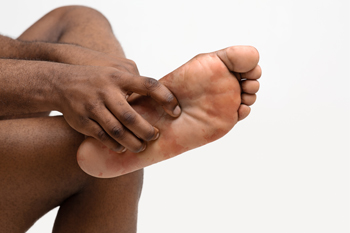
Erythromelalgia, a rare disorder that primarily affects the feet, casts a shadow over the lives of those afflicted. It is thought to occur as a result of the dysfunction of certain blood vessels that may lead to abnormal blood flow affecting the feet. In this condition, the feet endure excruciating pain and inflammation, often described as burning, stabbing, or throbbing sensations. Despite its rarity, erythromelalgia's effects are profound, disrupting daily routines and causing immense discomfort. Affected individuals may find solace only in cooling measures, as warmth exacerbates symptoms. The distinctive symptom of this disorder lies in the visible manifestation on the feet, which is a striking redness and warmth, similar to a fiery glow, that distinguishes it from other ailments. Walking, standing, or even wearing shoes become arduous tasks, imposing significant limitations on mobility and quality of life. Understanding the nuances of erythromelalgia is imperative, shedding light on its silent but profound impact on the feet and the lives it touches. If you or someone you know is affected by this rare foot disease, it is strongly suggested that you are under the care of a podiatrist who can help you manage this painful condition.
Some foot conditions may require additional professional care. If you have any concerns, contact the podiatrists of The Foot & Ankle Center of New Jersey. Our doctors can provide the care you need to keep you pain-free and on your feet.
Rare Foot Conditions
The majority of foot conditions are common and can be treated by a podiatrist. Standard diagnostic procedures are generally used to identify specific conditions and treatment can be rendered. A podiatrist also treats rare foot conditions which can be difficult to diagnose and may need extra attention and care.
There are many rare foot conditions that can affect children. Some of these can include:
Freiberg’s disease - This can be seen as a deterioration and flattening of a metatarsal bone that exists in the ball of the foot. It typically affects pre-teen and teenage girls, but can affect anyone at any age. Symptoms that can accompany this can be swelling, stiffness, and the patient may limp.
Kohler’s disease - This often targets the bone in the arch of the foot and affects younger boys. It can lead to an interruption of the blood supply which ultimately can lead to bone deterioration. The patient may limp or experience tenderness, swelling, and redness.
Maffucci syndrome - This affects the long bones in a child’s foot leading to the development of abnormal bone lesions. They are benign growths and typically develop in early childhood and the bones may be susceptible to breaking.
A podiatrist can properly diagnose and treat all types of rare foot conditions. If your child is affected by any of these symptoms or conditions, please don’t hesitate to call our office so the correct treatment method can begin.
If you have any questions please feel free to contact our office located in Paramus, NJ . We offer the newest diagnostic tools and technology to treat your foot and ankle needs.
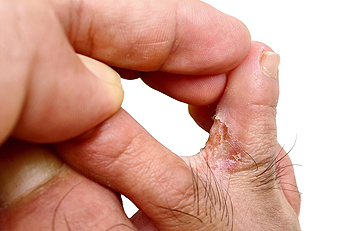
Athlete's foot, a fungal infection affecting the skin of the feet, is often closely intertwined with hygiene practices. Fungi thrive in warm, moist environments, making sweaty socks and tight shoes ideal breeding grounds. Poor foot hygiene, such as infrequent washing or drying between toes, exacerbates the risk of infection. Additionally, walking barefoot in shared spaces like gym showers or swimming pools increases exposure to the fungus. Athletes, hence the name, are particularly susceptible due to prolonged periods of sweaty feet and communal locker rooms. Symptoms include itching, burning, and cracked skin, often between the toes or on the soles of the feet. Fortunately, maintaining good foot hygiene can help prevent athlete's foot. Regularly wash and thoroughly dry feet, especially between the toes, and wear clean, breathable socks and shoes, it is helpful to avoid sharing footwear or walking barefoot in public areas. If you have developed athlete’s foot, it is suggested that you visit a podiatrist who can offer you effective medication for treatment.
Athlete’s Foot
Athlete’s foot is often an uncomfortable condition to experience. Thankfully, podiatrists specialize in treating athlete’s foot and offer the best treatment options. If you have any questions about athlete’s foot, consult with the podiatrists from The Foot & Ankle Center of New Jersey. Our doctors will assess your condition and provide you with quality treatment.
What Is Athlete’s Foot?
Tinea pedis, more commonly known as athlete’s foot, is a non-serious and common fungal infection of the foot. Athlete’s foot is contagious and can be contracted by touching someone who has it or infected surfaces. The most common places contaminated by it are public showers, locker rooms, and swimming pools. Once contracted, it grows on feet that are left inside moist, dark, and warm shoes and socks.
Prevention
The most effective ways to prevent athlete’s foot include:
Symptoms
Athlete’s foot initially occurs as a rash between the toes. However, if left undiagnosed, it can spread to the sides and bottom of the feet, toenails, and if touched by hand, the hands themselves. Symptoms include:
Diagnosis and Treatment
Diagnosis is quick and easy. Skin samples will be taken and either viewed under a microscope or sent to a lab for testing. Sometimes, a podiatrist can diagnose it based on simply looking at it. Once confirmed, treatment options include oral and topical antifungal medications.
If you have any questions, please feel free to contact our office located in Paramus, NJ . We offer the newest diagnostic and treatment technologies for all your foot care needs.
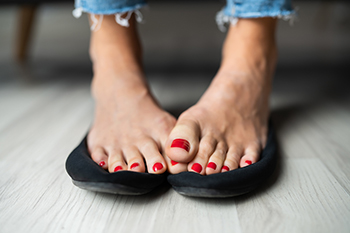
Plantar hyperhidrosis, a condition marked by excessive sweating of the feet, poses unique challenges for those affected. This phenomenon, often overlooked, can significantly impact daily life, leading to discomfort, embarrassment, and even social withdrawal. The underlying mechanisms driving this condition remain complex, involving overactive sweat glands triggered by factors such as genetics, hormonal imbalances, or neurological conditions. While commonly dismissed as a mere inconvenience, plantar hyperhidrosis warrants attention due to its far-reaching implications. Beyond the discomfort and odor associated with perpetually moist feet, this condition predisposes individuals to fungal infections, necessitating diligent foot care routines. Despite its prevalence, awareness surrounding plantar hyperhidrosis remains limited, heightening the stigma and isolation experienced by those grappling with it. If you have developed plantar hyperhidrosis, it is suggested that you visit a podiatrist who can offer you relief and management techniques.
If you are suffering from hyperhidrosis contact the podiatrists of The Foot & Ankle Center of New Jersey. Our doctors can provide the care you need to attend to all of your foot and ankle needs.
Hyperhidrosis of the Feet
Hyperhidrosis is a rare disorder that can cause people to have excessive sweating of their feet. This can usually occur all on its own without rigorous activity involved. People who suffer from hyperhidrosis may also experience sweaty palms.
Although it is said that sweating is a healthy process meant to cool down the body temperature and to maintain a proper internal temperature, hyperhidrosis may prove to be a huge hindrance on a person’s everyday life.
Plantar hyperhidrosis is considered to be the main form of hyperhidrosis. Secondary hyperhidrosis can refer to sweating that occurs in areas other than the feet or hands and armpits. Often this may be a sign of it being related to another medical condition such as menopause, hyperthyroidism and even Parkinson’s disease.
In order to alleviate this condition, it is important to see your doctor so that they may prescribe the necessary medications so that you can begin to live a normal life again. If this is left untreated, it is said that it will persist throughout an individual’s life.
A last resort approach would be surgery, but it is best to speak with your doctor to find out what may be the best treatment for you.
If you have any questions please feel free to contact our office located in Paramus, NJ . We offer the newest diagnostic and treatment technologies for all your foot and ankle needs.
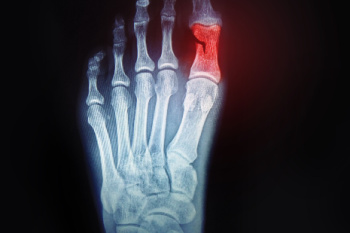
Broken toes, while often underestimated, can significantly impact daily activities and mobility. Common causes of broken toes include traumatic injuries such as stubbing or dropping heavy objects on the foot, as well as sports-related incidents and accidents. Symptoms of a broken toe typically include pain, swelling, bruising, and difficulty bearing weight on the affected foot. In severe cases, the toe may appear visibly misaligned or deformed, and there may be an audible popping or cracking sound at the time of injury. Additionally, individuals may experience numbness or tingling sensations in the affected toe. The appearance of a broken toe can vary depending on the severity of the injury, with some cases showing obvious signs of displacement or angulation, while others may have subtle swelling and discoloration. If you have fractured your toe, it is suggested that you consult a podiatrist who can perform an accurate diagnosis, and offer the treatment method that is best for you.
A broken toe can be very painful and lead to complications if not properly fixed. If you have any concerns about your feet, contact the podiatrists from The Foot & Ankle Center of New Jersey. Our doctors will treat your foot and ankle needs.
What to Know About a Broken Toe
Although most people try to avoid foot trauma such as banging, stubbing, or dropping heavy objects on their feet, the unfortunate fact is that it is a common occurrence. Given the fact that toes are positioned in front of the feet, they typically sustain the brunt of such trauma. When trauma occurs to a toe, the result can be a painful break (fracture).
Symptoms of a Broken Toe
Generally, it is best to stay off of the injured toe with the affected foot elevated.
Severe toe fractures may be treated with a splint, cast, and in some cases, minor surgery. Due to its position and the pressure it endures with daily activity, future complications can occur if the big toe is not properly treated.
If you have any questions please feel free to contact our office located in Paramus, NJ . We offer the newest diagnostic and treatment technologies for all your foot and ankle needs.

Ingrown toenails can be a source of discomfort and pain, often requiring medical attention from a podiatrist to alleviate symptoms and prevent complications. When conservative treatments fail to provide relief, surgery becomes a viable option. During the procedure, the offending portion of the nail is removed to prevent it from growing into the surrounding skin. It is important to note that ingrown toenail surgery is generally performed on an outpatient basis, meaning patients can return home the same day. Recovery times may vary, but patients can expect some discomfort and swelling in the days following surgery. However, diligent care of the surgical site and following post-operative instructions can expedite healing and minimize complications. Ultimately, ingrown toenail foot surgery offers a long-term solution for those suffering from persistent ingrown toenail pain. If you have an ingrown toenail that is causing you chronic discomfort, it is strongly suggested that you consult a podiatrist for an evaluation.
Foot surgery is sometimes necessary to treat a foot ailment. To learn more, contact the podiatrists of The Foot & Ankle Center of New Jersey. Our doctors will assist you with all of your foot and ankle needs.
When Is Surgery Necessary?
Foot and ankle surgery is generally reserved for cases in which less invasive, conservative procedures have failed to alleviate the problem. Some of the cases in which surgery may be necessary include:
What Types of Surgery Are There?
The type of surgery you receive will depend on the nature of the problem you have. Some of the possible surgeries include:
Benefits of Surgery
Although surgery is usually a last resort, it can provide more complete pain relief compared to non-surgical methods and may allow you to finally resume full activity.
Surgical techniques have also become increasingly sophisticated. Techniques like endoscopic surgery allow for smaller incisions and faster recovery times.
If you have any questions please feel free to contact our office located in Paramus, NJ . We offer the newest diagnostic and treatment technologies for all your foot and ankle needs.
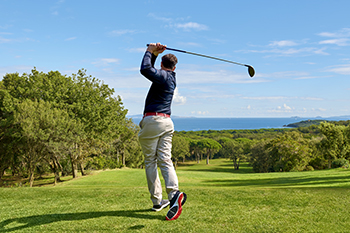
Golf, a sport renowned for its precision and finesse, demands proper foot and ankle protection to optimize performance and prevent injuries on the course. As golfers traverse various terrains and weather conditions, selecting appropriate footwear is vital. Choose golf shoes with sturdy yet flexible soles that provide traction on grass and uneven surfaces, ensuring stability during swings and walks. Look for designs with ample cushioning and arch support to mitigate the impact of repetitive motions and reduce the risk of foot fatigue or discomfort throughout the round. Consider weather-resistant options to keep feet dry and comfortable in inclement conditions. Additionally, prioritize shoes that offer ankle support to minimize the risk of sprains or twists during swings and uneven terrain navigation. Regularly inspect and replace worn-out footwear to maintain optimal protection and performance. By investing in quality golf shoes that prioritize foot and ankle protection, golfers can enhance their experience on the course and enjoy their game to the fullest. If you are seeking specific information about what type of shoes provide maximum protection while playing golf, it is suggested that you confer with a podiatrist.
Sports related foot and ankle injuries require proper treatment before players can go back to their regular routines. For more information, contact the podiatrists of The Foot & Ankle Center of New Jersey. Our doctors can provide the care you need to keep you pain-free and on your feet.
Sports Related Foot and Ankle Injuries
Foot and ankle injuries are a common occurrence when it comes to athletes of any sport. While many athletes dismiss the initial aches and pains, the truth is that ignoring potential foot and ankle injuries can lead to serious problems. As athletes continue to place pressure and strain the area further, a mild injury can turn into something as serious as a rupture and may lead to a permanent disability. There are many factors that contribute to sports related foot and ankle injuries, which include failure to warm up properly, not providing support or wearing bad footwear. Common injuries and conditions athletes face, including:
Sports related injuries are commonly treated using the RICE method. This includes rest, applying ice to the injured area, compression and elevating the ankle. More serious sprains and injuries may require surgery, which could include arthroscopic and reconstructive surgery. Rehabilitation and therapy may also be required in order to get any recovering athlete to become fully functional again. Any unusual aches and pains an athlete sustains must be evaluated by a licensed, reputable medical professional.
If you have any questions please feel free to contact our office located in Paramus, NJ . We offer the newest diagnostic and treatment technologies for all your foot and ankle needs.
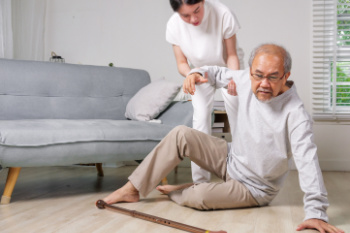
The feet can be affected by falling. In older adults, this may lead to them having difficulty in completing daily activities. Ensuring a safe living space for aging loved ones is vital for their well-being and independence. Begin by decluttering walkways and removing tripping hazards such as loose rugs or electrical cords. Install handrails along stairways and in bathrooms to provide stability and support. Secure carpets and rugs with non-slip backing to prevent slips and falls. Improve lighting throughout the home, especially in hallways, staircases, and entrances. Consider installing grab bars and shower chairs in bathrooms, and keep commonly used items within easy reach to avoid the need for reaching or bending over. Additionally, consider investing in assistive devices, such as mobility aids or medical alert systems, for added safety and peace of mind. Regularly assess the home environment for potential hazards, and make necessary adjustments to promote a secure and comfortable living environment for aging loved ones. If you are seeking additional falls prevention methods that can protect the feet, it is suggested that you consult a podiatrist who can offer you valuable information.
Preventing falls among the elderly is very important. If you are older and have fallen or fear that you are prone to falling, consult with the podiatrists from The Foot & Ankle Center of New Jersey. Our doctors will assess your condition and provide you with quality advice and care.
Every 11 seconds, an elderly American is being treated in an emergency room for a fall related injury. Falls are the leading cause of head and hip injuries for those 65 and older. Due to decreases in strength, balance, senses, and lack of awareness, elderly persons are very susceptible to falling. Thankfully, there are a number of things older persons can do to prevent falls.
How to Prevent Falls
Some effective methods that older persons can do to prevent falls include:
Falling can be a traumatic and embarrassing experience for elderly persons; this can make them less willing to leave the house, and less willing to talk to someone about their fears of falling. Doing such things, however, will increase the likelihood of tripping or losing one’s balance. Knowing the causes of falling and how to prevent them is the best way to mitigate the risk of serious injury.
If you have any questions, please feel free to contact our office located in Paramus, NJ . We offer the newest diagnostic and treatment technologies for all your foot care needs.
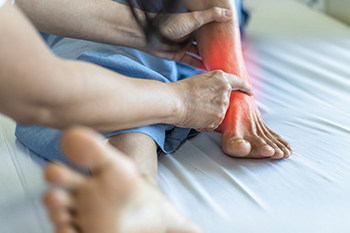
Tarsal tunnel syndrome is a painful condition caused by compression of the tibial nerve as it passes through the tarsal tunnel, a narrow passageway on the inner side of the ankle. This compression leads to symptoms such as numbness, tingling, burning sensations, and sharp pain along the inner ankle and the sole of the foot. The exact cause of tarsal tunnel syndrome can vary, but often includes factors such as injury, trauma, overuse, flat feet, swelling, or the presence of benign growths within the tunnel. Additionally, conditions like arthritis, diabetes, or nerve-related disorders can increase the risk of developing this syndrome. In severe cases, corticosteroid injections or surgical intervention to release the tibial nerve may be necessary to relieve pressure and restore normal nerve function. If you are experiencing ankle pain, it is suggested that you visit a podiatrist who can accurately diagnose tarsal tunnel syndrome, and guide you toward effective treatment methods.
Tarsal tunnel syndrome can be very uncomfortable to live with. If you are experiencing tarsal tunnel syndrome, contact the podiatrists of The Foot & Ankle Center of New Jersey. Our doctors can provide the care you need to keep you pain-free and on your feet.
Tarsal Tunnel Syndrome
Tarsal tunnel syndrome, which can also be called tibial nerve dysfunction, is an uncommon condition of misfiring peripheral nerves in the foot. The tibial nerve is the peripheral nerve in the leg responsible for sensation and movement of the foot and calf muscles. In tarsal tunnel syndrome, the tibial nerve is damaged, causing problems with movement and feeling in the foot of the affected leg.
Common Cause of Tarsal Tunnel Syndrome
The Effects of Tarsal Tunnel Syndrome
A physical exam of the leg can help identify the presence of tarsal tunnel syndrome. Medical tests, such as a nerve biopsy, are also used to diagnose the condition. Patients may receive physical therapy and prescriptive medication. In extreme cases, some may require surgery.
If you have any questions please feel free to contact our office located in Paramus, NJ . We offer the newest diagnostic and treatment technologies for all your foot and ankle needs.